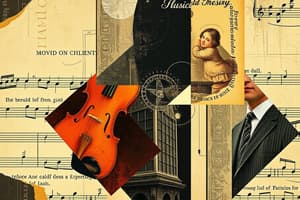Podcast
Questions and Answers
What years did the Classical Period in music span?
What years did the Classical Period in music span?
1750-1820
What type of texture is more common in Classical music compared to Baroque music?
What type of texture is more common in Classical music compared to Baroque music?
- Homophonic (correct)
- Polyphonic
- Monophonic
- Atonal
What is a characteristic of Classical architecture and music?
What is a characteristic of Classical architecture and music?
Symmetrical
What emotional characteristic was prominent during the Classical Era?
What emotional characteristic was prominent during the Classical Era?
What structure is typically followed in a classical symphony's first movement?
What structure is typically followed in a classical symphony's first movement?
Which of these describes the Classical Symphony?
Which of these describes the Classical Symphony?
What are the common characteristics of classical music?
What are the common characteristics of classical music?
What is the term for the gradual increase and decrease in dynamics commonly used in Classical music?
What is the term for the gradual increase and decrease in dynamics commonly used in Classical music?
What is the composition made for a solo instrumentalist and orchestra that typically lasts 20-45 minutes?
What is the composition made for a solo instrumentalist and orchestra that typically lasts 20-45 minutes?
Match the following composers with their key contributions:
Match the following composers with their key contributions:
What is the term for the musical form characterized by the return of the main theme alternating with secondary themes?
What is the term for the musical form characterized by the return of the main theme alternating with secondary themes?
Flashcards are hidden until you start studying
Study Notes
Classical Period Overview
- Timeframe: 1750 to 1820, significant development in Western art music.
- Characterized by contrast in musical moods; pieces no longer confined to a single emotion.
Texture in Music
- Transition from Baroque polyphony to Classical homophony.
- Classical compositions feature clearer melodies accompanied by harmonies.
Architectural Influence
- Symmetry, a key characteristic of Classical music and architecture, emphasizes balance and proportion.
Symphony Structure
- Classical symphonies typically consist of four movements:
- Fast dramatic first movement.
- Slow lyrical second movement.
- Dance-like third movement, either a minuet or scherzo.
- Fast heroic fourth movement.
- Overall duration ranges from 20 to 45 minutes, with the first movement usually following Sonata Allegro form.
Key Characteristics of Classical Music
- Diversity of mood and emotion is prevalent.
- Rhythmic patterns are varied, including surprising pauses and syncopation.
- Texture predominantly homophonic, with some pieces incorporating polyphony and imitation.
- Use of crescendos and decrescendos; dynamic changes became a prominent feature.
- Shift from basso continuo to fully notated music for control over performances.
Evolution of the Classical Orchestra
- Standardized orchestral sections include:
- Strings: first and second violins, violas, cellos, bass.
- Woodwinds: two flutes, two oboes, two clarinets, two bassoons.
- Brass: two French horns, two trumpets.
- Percussion: timpanis.
Sonata Form
- Often employed for the first movement of symphonies and concertos.
- Structure: Introduction, Exposition (A), Development (B), Recapitulation (A), and Coda.
- Exposition features themes in tonic and new keys, while Development explores different modulations.
Dance Forms
- Minuet and Trio: Traditional third movement of classical works in A-B-A format.
- Scherzo: A lively alternative to the minuet, often in triple meter.
- Rondo: Musical form featuring repeated main themes interspersed with contrasting themes (e.g., ABABA, ABACA).
Classical Concerto
- Showcases an instrumental soloist against an orchestra backdrop; typically in three movements.
- Cadenzas allow soloists to display technical prowess; originally improvised, but later written out.
Chamber Music
- String quartet configuration of two violins, viola, and cello.
- Structure generally includes four movements, with a mix of fast and slow tempos.
Notable Composers
-
Joseph Haydn:
- Influential in popularizing the symphony; known for humor in compositions.
- Composed over 100 symphonies, including the famous "Surprise Symphony."
-
Wolfgang Amadeus Mozart:
- Prolific composer known for operas, symphonies, and concertos.
- Renowned works include "Don Giovanni," "The Marriage of Figaro," and "Eine Kleine Nachtmusik."
-
Ludwig van Beethoven:
- Bridged Classical and Romantic eras through innovative compositions.
- Famous for symphonies such as the Eroica, Fifth, and Ninth ("Choral").
- Continued composing despite hearing loss; received financial support from patrons.
Sonata No. 5
- Composed with four movements featuring varied forms, including Sonata Allegro and expanded theme and variations.
Classical Forms
- Notable forms in Classical music include Sonata Allegro and Theme and Variations, showcasing structural complexity and thematic development.
Studying That Suits You
Use AI to generate personalized quizzes and flashcards to suit your learning preferences.



